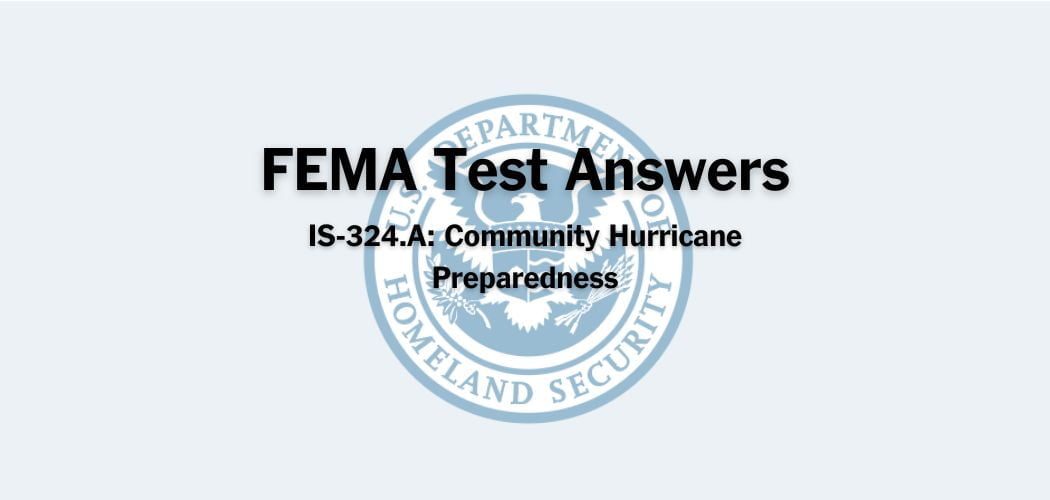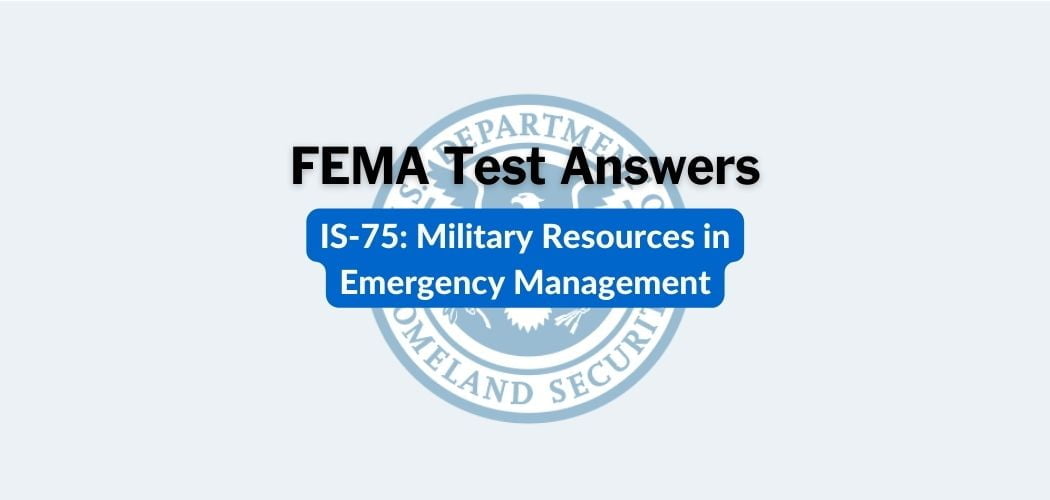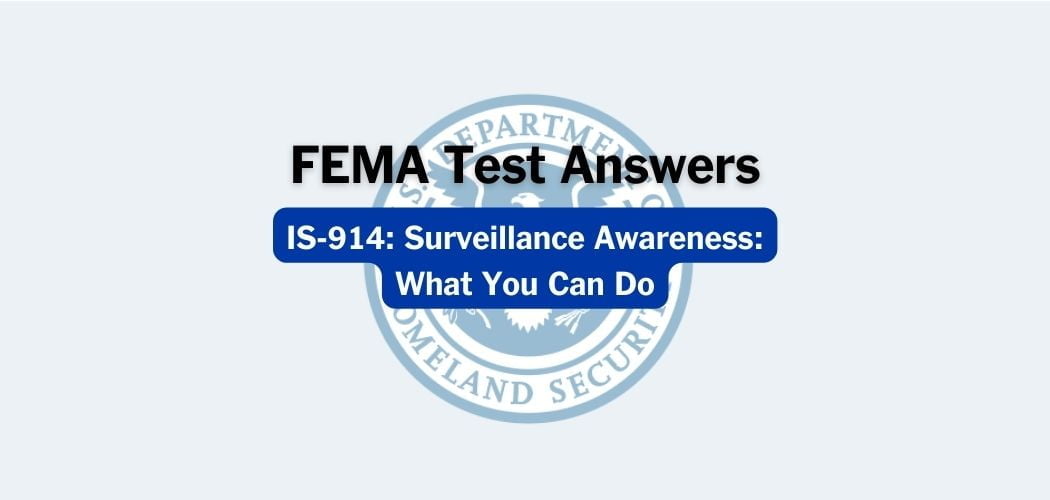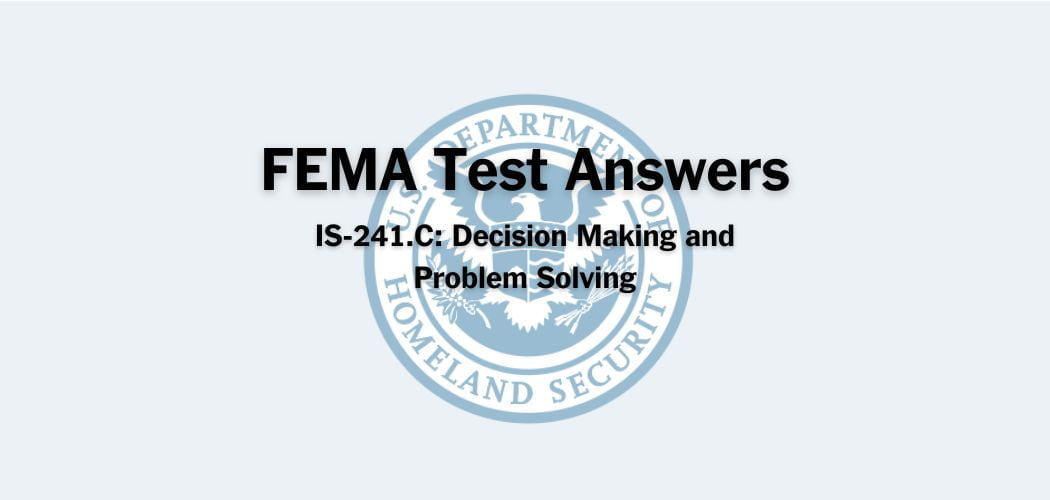Overview: FEMA IS-111.A course was published on 10/31/2013 and combines the knowledge of livestock producers and emergency managers to present a unified approach to mitigate the impact of disasters on animal agriculture.
Objectives: The IS-111.A course aims to understand issues that arise when disasters affect livestock, determine a farm’s susceptibility to hazards, and identify actions to reduce economic losses and human and animal suffering in disasters.
FEMA IS-111.A test answers
Each time this test is loaded, you will receive a unique set of questions and answers. The test questions are scrambled to protect the integrity of the exam.
Question 1. Which of the following statements accurately describes disaster assistance?
A. In large-scale disasters, the Director of Emergency Management is responsible for declaring a disaster.
B. State disaster declarations can only be made when more than one community is affected.
C. Volunteer organizations are the only source of disaster assistance at the local level.
D. For a State to qualify for Federal disaster assistance from FEMA, it is best if the State has laws that are consistent with those of Federal emergency management law. ✅
Question 2. Which of the following statements is correct regarding droughts?
A. Proper watershed, forest, and rangeland management is an effective mitigation against droughts.
B. Spreading livestock operations out among several states is an effective mitigation against weather-related disasters.
C. Reducing personal water usage helps reduce the impact of droughts.
D. All of the above. ✅
Question 3. Which of the following statements is correct regarding the disposal of carcasses?
A. Large-scale disposal of carcasses can be contracted to specialty firms that deal with hazardous materials disposal, such as from superfund sites.
B. Composting is no longer used to dispose of any livestock carcasses.
C. The disposal of carcasses must require the permission of the State or Federal Environmental Protection Agency and Department of Natural Resources. ✅
D. Carcasses must be disposed of onsite.
Question 4. Which of the following statements correctly describes liability issues in disasters?
A. The owner of an escaped animal may be held liable for damages his/her animal creates. ✅
B. The local Department of Animal Control is the legal entity in most communities to deal with abandoned and lost animals.
C. In most States, Good Samaritan Laws do not directly apply to the care of animals.
D. All of the above.
Question 5. Which of the following statements is correct regarding a Foreign Animal Disease outbreak?
A. Practicing veterinarians are the officials who must conduct the investigation of a suspected Foreign Animal Disease. ✅
B. Freedom from a Foreign Animal Disease in a country (such as Foot and Mouth Disease) usually includes being free of clinical disease and vaccinating against the disease.
C. The most likely route of entry of a Foreign Animal Disease is from the wind blowing the agent across the borders.
D. Authoritative reports of a Foreign Animal Disease are made by the Chief Veterinary Official (CVO) for the United States.
Question 6. Which of the following statements are correct regarding injuries and damages that result from earthquakes?
A. Most human injuries in earthquakes result from falling objects.
B. Place large and heavy objects on lower shelves and securely fasten shelves taller than 5 feet to walls. Brace anchor all tall or top-heavy objects.
C. Housing animals so that heavy objects do not fall on them in earthquakes is an important preparedness activity for earthquakes.
D. All of the above. ✅
Question 7. Which of the following statements characterizes effective disaster preparedness plans?
A. Local plans allow communities to integrate with state and federal response to disasters.
B. Emergency Operations Plans work best within organizational structures responsive to non-emergency duties that are similar to the duties needed in disasters.
C. One of the purposes of an Emergency Operations Plan is to provide an overview of the community’s jurisdiction.
D. All of the above. ✅
Question 8. Which of the following statements is correct regarding heat stress in livestock?
A. Livestock are resistant to heat stress.
B. Under extreme heat conditions, livestock require less than 10% body weight of water per day.
C. Do not dress animals with vests, blankets, and other materials that would prevent them from sweating. ✅
D. Heat stress in animals only occurs under conditions of extreme heat.
Question 9. Which of the following statements is correct regarding the human food supply in disasters?
A. Even though smoke residues can be harmful to livestock, if livestock has been exposed to smoke residues they can be used for human consumption without concern.
B. If livestock raised for human consumption are removed from a farm, care must be taken that the animals are not exposed to diseases or hazardous materials that could threaten the human food supply. ✅
C. If escaped livestock ingests toxic plants, their milk is likely to still be suitable for human consumption.
D. Intoxications of livestock are common in disasters, but there are no concerns over the safety of the human food supply.
Question 10. Why is livestock agriculture thought to be more vulnerable to disasters now than in 1900?
A. Livestock agriculture is more widely dispersed than ever before.
B. Livestock agriculture’s reliance on machines and technology has increased the need for evacuation procedures. ✅
C. Intensification of U.S. dairy production has manifested itself as lower productivity of individual cows.
D. Intensification and consolidation have resulted in an increased number of animals living in a smaller space.
Question 11. Which of the following statements correctly describes animal disease outbreaks?
A. Costs from animal disease outbreaks include loss of production and replacement of animals. ✅
B. Biosecurity is the principal method to mitigate (prevent, reduce) disease outbreaks.
C. To prevent the introduction of disease to farms, delivery and dispatch points on farms should be located away from livestock.
D. All of the above.
Question 12. Which of the following statements are correct?
A. Effective biosecurity on farms includes restricting access to feed storage bins to authorized persons only.
B. An outbreak of a Foreign Animal Disease in the U.S. would likely require the disposal of large numbers of carcasses.
C. New animal arrivals to a farm should be placed in quarantine until a suitable time has lapsed to rule out the introduction of contagious disease.
D. All of the above. ✅
Question 13. Which of the following statements apply to the transportation of livestock?
A. The response to transportation accidents often requires coordination among law enforcement, fire department, emergency management, the hauler, and the owner.
B. Mitigation of transportation accidents involves the use of properly designed trailers and regular trailer maintenance.
C. Do not tie animals to unhitched trailers, as many animals are strong enough to pull the trailer away.
D. All of the above. ✅
Question 14. Which of the following statements is correct regarding snowfall?
A. Ice dams on roofs and large icicles are uncommon causes of building collapse.
B. Buildings should be separated by at least 30 to 50 feet to prevent snowdrifts from developing between them.
C. Snow has to fall at rates of greater than 12 inches per hour to cause severe disruptions. ✅
D. Small amounts of snow never have devastating effects on a community.
Question 15. Which of the following statements describes appropriate procedures for dealing with animal health/disease?
A. Under emergency conditions, animal health services should always be provided by the person who is closest to the scene.
B. Only animals intended for human consumption require an official health permit signed by a veterinarian when moved across State lines.
C. Veterinarians don’t know much about the clinical aspects of food animals exposed to hazardous chemicals.
D. All suspect findings of Foreign Animal Diseases have to be reported to State or Federal veterinarians. ✅
Question 16. Which of the following statements describe effective operations in disasters?
A. The use of an out-of-area contact can be an effective way to coordinate in disasters.
B. The Incident Command System provides a consistent method to respond to all types of emergencies. ✅
C. Each responding agency and group should operate independently and separately from the others, in order to cover more ground.
D. All of the above.
Question 17. Which of the following statements is correct regarding hurricanes?
A. Even when a storm surge has flooded a pasture land, livestock can be left to graze without concern for injuries.
B. If there is a boil-water order in effect, do not drink or give animals tap water unless you know it is safe. ✅
C. Hurricanes frequently cause flooding along the coast, but not inland.
D. A good time to check your window shutters and supply of boards, tools, batteries, nonperishable foods, bottled water, and other equipment is during a hurricane watch.
Question 18. Which of the following statements is correct about the behavior of landslides?
A. Damage from mudflows cannot be covered by insurance.
B. Accumulation of water and bulging ground at the bottom of slopes are normal occurrences after heavy rains.
C. Planting deep-rooted ground cover is an effective mitigation measure against landslides. ✅
D. Landslides rarely affect the agricultural property.
Question 19. Which of the following is NOT relevant to the care of animals in floods?
A. Floodwaters are frequently contaminated with hazardous chemicals.
B. Animals that have recently moved from a warmer to a colder climate are at a greater risk of hypothermia than animals that have lived in a colder climate for longer periods.
C. The number of animals that need to be evacuated from a farm is an important factor in determining how quickly a farm can be evacuated.
D. Animals will frequently resist walking through flowing water. ✅
Question 20. Which of the following accurately describes the relationship between disasters and the economic impact on livestock farmers?
A. The only loss in disasters is to affected farms.
B. When disasters affect many livestock farms in a county it is unlikely that this will represent a significant loss to the county’s tax base. ✅
C. Pre-existing economic difficulties can exacerbate the impact of disasters on livestock farmers.
D. Large-scale disasters affecting livestock never have serious implications for State revenues.
Question 21. Which of the following correctly describes the role of the USDA in disasters?
A. Indemnity payments to farmers for crop losses that are covered by insurance are managed by the USDA Risk Management Agency.
B. Disaster advice from the USDA is provided by the Cooperative Extension Service.
C. Emergency loans from the USDA in disasters are managed by the Farm Service Agency.
D. All of the above. ✅
Question 22. Which of the following statements is/are correct regarding the humane care of animals in disasters?
A. Disasters can be a threat to animal well-being.
B. Livestock that is adapted to cold can tolerate low temperatures if they have adequate feed intake.
C. Guidelines for proper methods for euthanasia for livestock are available from the veterinary, producer, and humane groups.
D. All of the above. ✅
Question 23. Which of the following are effective MITIGATION (reduction, prevention) activities for farms?
A. Purchasing a generator as an alternative power supply.
B. Crop insurance to protect against the effects of summer storms.
C. Construction of a new barn at a site above a floodplain.
D. All of the above. ✅
Question 24. Which of the following statements is correct regarding floods?
A. Hazardous materials released during floods will flow away with the water.
B. Never tie an animal up if floods are pending. ✅
C. Only if flowing water is above your waist is it too high to cross.
D. Floods are an uncommon cause of natural disasters in the United States.
Question 25. Which of the following statements is correct regarding the identification of animals in disasters?
A. Unique and permanent identification for all animals would be of little help in reuniting animals with their correct owner in disasters.
B. Documentation of ownership may be needed to reclaim a lost animal. ✅
C. Emergency managers are responsible for finding the owners of all lost animals.
D. Many animals look sufficiently distinct for most persons other than the owner to be able to distinguish one animal from another.
Question 26. Which of the following statements regarding thunderstorms is correct?
A. It is necessary for it to be raining to be struck by lightning.
B. Thunderstorms and their consequences are common, but rarely create problems.
C. Annual property loss resulting from thunderstorms, including damage to farms and barns, is estimated in the hundreds of millions of dollars. ✅
D. Sustained winds of more than 20 mph and hail greater than or equal to 2 inches in diameter are characteristic of severe thunderstorms.
Question 27. Which of the following statements will NOT reduce risks arising from wildfires?
A. Having fire tools handy at your home and in your barn: a ladder, garden hoses, fire extinguishers, gas-operated water pumps, shovels, rakes, and buckets.
B. Designating access to barns and water for firefighters.
C. Practice a fire drill every month throughout the fire season.
D. Allowing people to smoke in barns. ✅
Question 28. Which of the following statements correctly describes the role of the Federal Emergency Management Agency (FEMA) in disasters?
A. An important role of FEMA in disasters is the coordination of response and recovery activities in declared major disasters.
B. FEMA helps States by reviewing and coordinating State emergency plans.
C. FEMA is a primary source of education on disaster management in the U.S.
D. All of the above. ✅
Question 29. Which of the following statements accurately describes the activation of federal agencies in disasters?
A. Federal agencies are usually activated directly in response to requests from local emergency managers.
B. The National Veterinary Response Team (NVRT) is part of disaster response through the Environmental Protection Agency (EPA).
C. The Department of Health and Human Services (DHHS) is responsible for overseeing the safety of the environment in the U.S.
D. The USDA responds to disasters that threaten national food production, processing, and distribution. ✅
Question 30. Which of the following statements is correct regarding disasters?
A. Personal preparedness is rarely effective at minimizing losses from disasters.
B. Most natural disasters affect local communities least of all.
C. Disasters are declared starting at the local, then state, then federal level. ✅
D. FEMA is responsible for reducing and reimbursing all personal losses in disasters.



